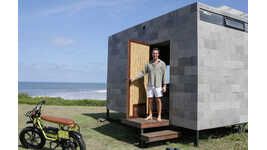While the fashion industry is being impacted by the current pandemic, new designs are emerging to encourage social distancing between people—including Livable's Well-Distance-Being project, which introduces wearable rattan cages. The hourglass-shaped design underlines the importance of keeping a safe distance from others and it boasts a form that resembles a Victorian crinoline, although the cage protects the face and rests on the shoulders rather than the waist.
The Well-Distance-Being project was created in response to the United Nations' Global Call Out to Creatives, which asked for people to communicate a public health message in a creative and understandable way. Although the structure is smaller than the recommended distance people are meant to keep from others to flatten the curve, Livable founder Sep Verboom emphasizes that the design is meant to remind of the need for physical distance.
Wearable Rattan Cages
Livable's Well-Distance-Being Encourages People to Keep Their Distance
Trend Themes
1. Wearable Rattan Cages - The development of wearable rattan cages as a social distancing measure presents a trend that could be adopted by others in the fashion industry.
2. Creative Social Distancing Designs - The emergence of socially distant fashion designs presents opportunities for other creatives to develop innovative designs that prioritize safety and health.
3. Public Health Messaging Through Fashion - The Well-Distance-Being project demonstrates how fashion can be leveraged to communicate important public health messages.
Industry Implications
1. Fashion Industry - The fashion industry has the opportunity to design and produce innovative socially distant fashion designs.
2. Public Health - The development of socially distant fashion designs is a potential disruptor in public health as it offers creative and innovative solutions to pressing health concerns.
3. Design and Creatives - Designers and creatives can utilize their skills and expertise to develop innovative designs that prioritize safety, thus filling the gap in the market for health-focused designs.




